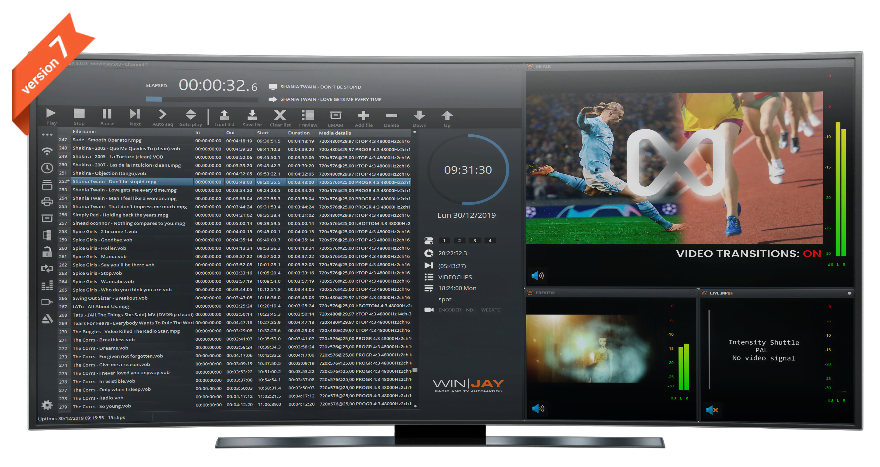Playout is the unsung hero of the broadcasting world. While audiences enjoy their favorite shows and programs, the meticulous work of scheduling, automating, controlling, and complying goes unnoticed. The concept has undergone continuous evolution, with its definition varying significantly over time and across different industries. Whether it’s television series or breaking news, the final step in ensuring this content reaches viewers is known as “playout”. This process, while often behind the scenes, is the backbone of any successful broadcast operation. Join us on a quick journey into this crucial aspect of broadcasting.
What is playout?
Playout refers to the end-to-end workflow, equipment and software applications required to bring together various forms of media content – live broadcasts, pre-recorded shows, commercials – schedule and deliver them in a coherent and timely manner to the intended audience. This final stage in the broadcasting chain involves a series of meticulously coordinated steps to ensure that the content airs correctly, without interruptions or errors. The efficiency and reliability of the playout process is crucial to ensure that each element performs at the right time to create a pleasant watching experience to your audience.
Linear and non-linear playout
As you might have guessed, the term ‘non-linear’ refers to content delivered outside of a traditional, pre-planned schedule, being the video on demand (VOD) platforms like YouTube a perfect matching example. These platforms share a common goal: providing viewers with the content they want, whenever they want it.
However, many people still prefer curated content over creating their own playlists, valuing the experience of a channel arranging a captivating program sequence tailored to their tastes. This is why linear playout remains vital, even beyond over-the-air television, being not a case that YouTube is offering a “live” streaming mode. In this context, launching an online television channel, such as a 24/7 YouTube stream, showcases the enduring relevance of linear playout.
But what exactly is linear playout? Imagine a straight, unbroken line. Applied to TV, linear playout means media content flows in a scheduled sequence. It’s the traditional television model where your viewing experience relies on the program guide, eliminating the need for you to arrange the sequence yourself.
The concept of over-the-air television can be seamlessly applied to new streaming technologies. The medium changes, but the concept remains the same. This is exemplified by YouTube Live 24/7 channels, which, through a different approach from VOD, help broadcasters stand out in searches, making it an exciting and profitable endeavor for both new and established broadcasters.
How it evolved
Driven by impressive advancements in technology, the process of linear playout has evolved significantly over the years. From the early days of manual operation based on physical tapes to the modern era of digital automated systems, the journey has been marked by a relentless pursuit of efficiency and reliability. Today, broadcasters can leverage sophisticated equipment and applications based on the “channel-in-a-box” concept, like our moviejaySX. Such applications are carefully engineered to manage the whole playout process with unprecedented levels of control and flexibility.
Why it is so crucial
You can never overstate the importance of a robust playout system. In an age where audience expectations are higher than ever, broadcasters must deliver flawless content to stay competitive. Any disruption or error anywhere through the workflow can lead to viewer dissatisfaction, loss of trust, and potential financial repercussions. Automation reduces the risk of human error and enhances operational efficiency, ensuring smooth transitions between different media elements. Hence, investing in reliable infrastructure is crucial for any broadcaster aiming to provide a top-notch viewing experience.
Key features of playout
Key features of playout automation software, like our moviejaySX, include:
- Content Scheduling: this involves organizing and timing the sequence of programs, advertisements, and other media elements. Effective scheduling ensures that content plays at the designated times, maintaining the broadcast schedule’s integrity and flow.
- Flexibility: a playout automation software must be highly customizable, allowing broadcasters to tailor workflows, layouts, and automation rules according to their specific needs. This level of flexibility is crucial for large-scale operations with complex broadcasting requirements.
- Seamless content playback: the ability to manage a wide range of media types effortlessly. A well engineered application allows multiple codecs playback in the same playlist with adaptive resolution, up/down scaling, aspect ratio and frame rate adjustment. Such a feature greatly speeds up the workflow avodiing the waste of valuable resources on format conversion procedures.
- Integration: the ability to seamlessly integrate with a plethora of broadcasting tools and platforms, including content management systems, traffic systems, and advertisement planners. This ensures a streamlined workflow and efficient operation to handle the demands of broadcasters without compromising performance.
- Real-time graphic overlays: a well-developed applications normally integrates a CG engine, allowing to overlay multiple layers of captivating elements to deliver additional informations while enhancing the viewers’ experience. Such elements include tickers, pop-up animations, subtitles, real-time RSS, and many more.
- Multi-channel playout: allowsing simultaneous broadcasting of content across multiple TV channels from a single system, while sharing the same media sources.
- 24hours/7days reliability: to ensure uninterrupted broadcasting, reputable companies develop broadcast-grade automation software for 24/7 reliability, offering features like failover support, redundant playout, and real-time monitoring.
The moviejaySX playout automation
At WINJAY, playout is our core business. From 1999 we have been a leading developer of broadcast grade radio and TV playout automation systems. Our products range covers from small business to corporate automation, commercial splitting, Media Asset Management, music TV, ingest and compliance logging. WINJAY solutions are supplied with detailed documentation, training resources, and a premium technical support service. Such peculiarities are crucial for ensuring your safety and smooth operation, especially for handling complex configurations and troubleshooting issues.
Need any advice or further information on our range of products?
Get in touch now
FAQ
What is playout automation software?
A playout automation software automates the scheduling and playback of broadcast content, ensuring seamless transmission for television channels
What are the main industries using playout automation software?
Television networks, media companies, and large broadcasters primarily use playout automation software to manage extensive content libraries and multiple channels.
Is technical support necessary for using playout automation software?
Yes, technical support is crucial for ensuring the smooth operation of playout automation software, especially for handling complex configurations and troubleshooting issues.





